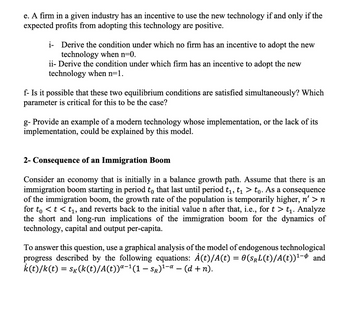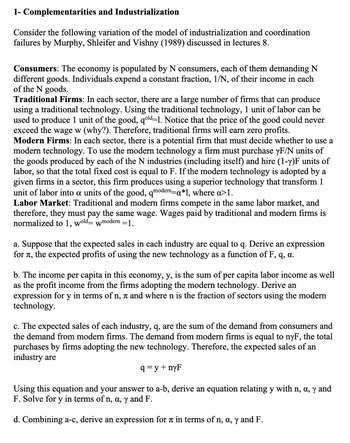
ENGR.ECONOMIC ANALYSIS
14th Edition
ISBN: 9780190931919
Author: NEWNAN
Publisher: Oxford University Press
expand_more
expand_more
format_list_bulleted
Question
1 E, F

Transcribed Image Text:e. A firm in a given industry has an incentive to use the new technology if and only if the
expected profits from adopting this technology are positive.
i-Derive the condition under which no firm has an incentive to adopt the new
technology when n=0.
ii- Derive the condition under which firm has an incentive to adopt the new
technology when n=1.
f- Is it possible that these two equilibrium conditions are satisfied simultaneously? Which
parameter is critical for this to be the case?
g- Provide an example of a modern technology whose implementation, or the lack of its
implementation, could be explained by this model.
2- Consequence of an Immigration Boom
Consider an economy that is initially in a balance growth path. Assume that there is an
immigration boom starting in period to that last until period t₁, t₁ > to. As a consequence
of the immigration boom, the growth rate of the population is temporarily higher, n' > n
for to < t < t₁, and reverts back to the initial value n after that, i.e., for t > t₁. Analyze
the short and long-run implications of the immigration boom for the dynamics of
technology, capital and output per-capita.
To answer this question, use a graphical analysis of the model of endogenous technological
progress described by the following equations: À(t)/A(t) = 0(SrL(t)/A(t))¹- and
k(t)/k(t) = Sk(k(t)/A(t))ª−¹(1 − Sr)¹−¤ − (d + n).

Transcribed Image Text:1- Complementarities
and Industrialization
Consider the following variation of the model of industrialization and coordination
failures by Murphy, Shleifer and Vishny (1989) discussed in lectures 8.
Consumers: The economy is populated by N consumers, each of them demanding N
different goods. Individuals expend a constant fraction, 1/N, of their income in each
of the N goods.
Traditional Firms: In each sector, there are a large number of firms that can produce
using a traditional technology. Using the traditional technology, 1 unit of labor can be
used to produce 1 unit of the good, qold-1. Notice that the price of the good could never
exceed the wage w (why?). Therefore, traditional firms will earn zero profits.
Modern Firms: In each sector, there is a potential firm that must decide whether to use a
modern technology. To use the modern technology a firm must purchase yF/N units of
the goods produced by each of the N industries (including itself) and hire (1-y)F units of
labor, so that the total fixed cost is equal to F. If the modern technology is adopted by a
given firms in a sector, this firm produces using a superior technology that transform 1
unit of labor into a units of the good, qmodern=a*1, where a>1.
Labor Market: Traditional and modern firms compete in the same labor market, and
therefore, they must pay the same wage. Wages paid by traditional and modern firms is
normalized to 1, wold- wmodern =1.
a. Suppose that the expected sales in each industry are equal to q. Derive an expression
for
TT, the expected profits of using the new technology as a function of F, q, a.
b. The income per capita in this economy, y, is the sum of per capita labor income as well
as the profit income from the firms adopting the modern technology. Derive an
expression for y in terms of n, à and where n is the fraction of sectors using the modern
technology.
c. The expected sales of each industry, q, are the sum of the demand from consumers and
the demand from modern firms. The demand from modern firms is equal to nyF, the total
purchases by firms adopting the new technology. Therefore, the expected sales of an
industry are
q=y+nyF
Using this equation and your answer to a-b, derive an equation relating y with n, a, y and
F. Solve for y in terms of n, a, y and F.
d. Combining a-c, derive an expression for a in terms of n, a, y and F.
Expert Solution
This question has been solved!
Explore an expertly crafted, step-by-step solution for a thorough understanding of key concepts.
Step by stepSolved in 4 steps with 13 images

Knowledge Booster
Learn more about
Need a deep-dive on the concept behind this application? Look no further. Learn more about this topic, economics and related others by exploring similar questions and additional content below.Similar questions
- Tract 1 123 2 3 4 Group A Group B 25 50 75 100 25 25 25 25 Calculate the dissimilarly index for this county.arrow_forwardThe ratio of Consumption to savings is given as 5/3 Calculate the value of savings if the value of income is $6000arrow_forwardTotal Total Total Product Fixed Variable (Blankets) Cost Cost 0 A 0 1 60 25 2 60 40 3 60 I 4 60 55 5 60 55 6 60 70 7 60 100 8 60 145 A What is the numerical value of B? A/ What is the numerical value of C? A/ Total Cost What is the numerical value of D? B 85 100 110 G 115 130 160 205 Average Average Average Variable Total Fixed Cost Cost cost - с 60 30 20 15 12 8.6 7.5 25 20 16.7 13.8 Ꭰ 11.7 14.3 18.1 E The table describes the short-run daily costs of the Baby Blanket Company. What is the numerical value of A? 85 36.7 28.8 J 21.7 22.9 25.6 Marginal Cost F H 15 10 0 15 30 45arrow_forward
- question part c should contain a grapharrow_forwardA doctor's office staff studied the waiting times for patients who arrive at the office with a request for emergency service. The following data with waiting times in minutes were collected over a one- month period. a. Fill in the frequency values below. Waiting Time Frequency 49 11 16 4 2 3 18 11 7 9 8 12 24 7 8 7 13 19 5 4 0-4 5-9 8 4 10-14 15-19 3 20-24 1 Total 20 b. Fill in the relative frequency (2 decimals) values below. Waiting Time Relative Frequency 0.2 0-4 5-9 0.4 0.2 10-14 15-19 0.15 20-24 0.05 Total 1arrow_forwardurgentarrow_forward
arrow_back_ios
arrow_forward_ios
Recommended textbooks for you

 Principles of Economics (12th Edition)EconomicsISBN:9780134078779Author:Karl E. Case, Ray C. Fair, Sharon E. OsterPublisher:PEARSON
Principles of Economics (12th Edition)EconomicsISBN:9780134078779Author:Karl E. Case, Ray C. Fair, Sharon E. OsterPublisher:PEARSON Engineering Economy (17th Edition)EconomicsISBN:9780134870069Author:William G. Sullivan, Elin M. Wicks, C. Patrick KoellingPublisher:PEARSON
Engineering Economy (17th Edition)EconomicsISBN:9780134870069Author:William G. Sullivan, Elin M. Wicks, C. Patrick KoellingPublisher:PEARSON Principles of Economics (MindTap Course List)EconomicsISBN:9781305585126Author:N. Gregory MankiwPublisher:Cengage Learning
Principles of Economics (MindTap Course List)EconomicsISBN:9781305585126Author:N. Gregory MankiwPublisher:Cengage Learning Managerial Economics: A Problem Solving ApproachEconomicsISBN:9781337106665Author:Luke M. Froeb, Brian T. McCann, Michael R. Ward, Mike ShorPublisher:Cengage Learning
Managerial Economics: A Problem Solving ApproachEconomicsISBN:9781337106665Author:Luke M. Froeb, Brian T. McCann, Michael R. Ward, Mike ShorPublisher:Cengage Learning Managerial Economics & Business Strategy (Mcgraw-...EconomicsISBN:9781259290619Author:Michael Baye, Jeff PrincePublisher:McGraw-Hill Education
Managerial Economics & Business Strategy (Mcgraw-...EconomicsISBN:9781259290619Author:Michael Baye, Jeff PrincePublisher:McGraw-Hill Education


Principles of Economics (12th Edition)
Economics
ISBN:9780134078779
Author:Karl E. Case, Ray C. Fair, Sharon E. Oster
Publisher:PEARSON

Engineering Economy (17th Edition)
Economics
ISBN:9780134870069
Author:William G. Sullivan, Elin M. Wicks, C. Patrick Koelling
Publisher:PEARSON

Principles of Economics (MindTap Course List)
Economics
ISBN:9781305585126
Author:N. Gregory Mankiw
Publisher:Cengage Learning

Managerial Economics: A Problem Solving Approach
Economics
ISBN:9781337106665
Author:Luke M. Froeb, Brian T. McCann, Michael R. Ward, Mike Shor
Publisher:Cengage Learning

Managerial Economics & Business Strategy (Mcgraw-...
Economics
ISBN:9781259290619
Author:Michael Baye, Jeff Prince
Publisher:McGraw-Hill Education